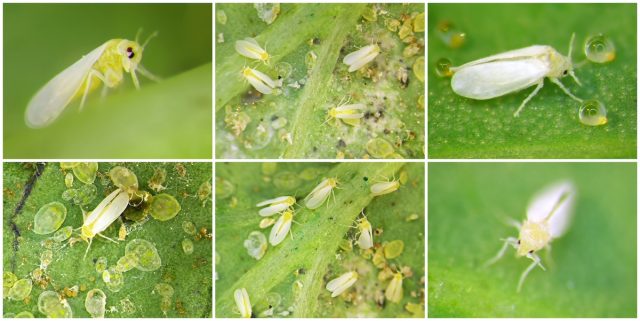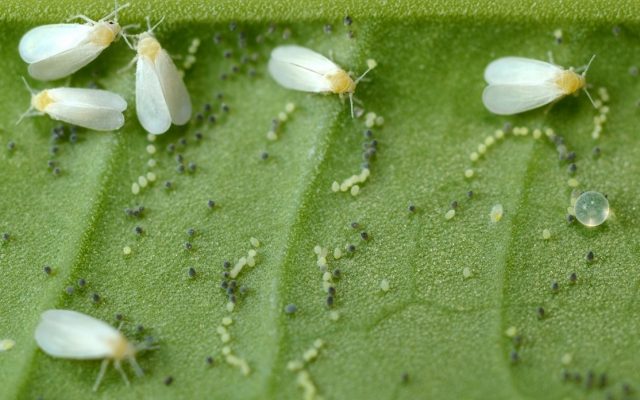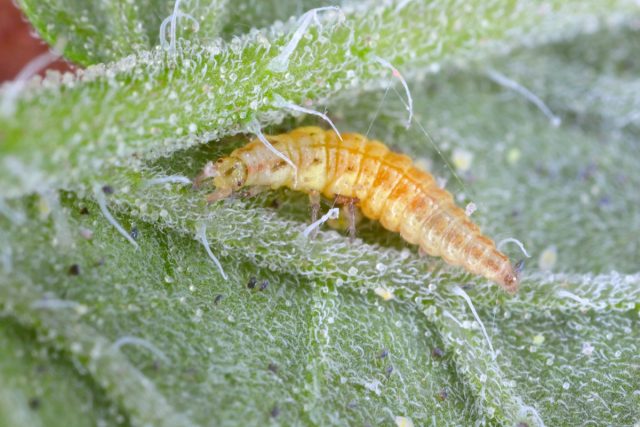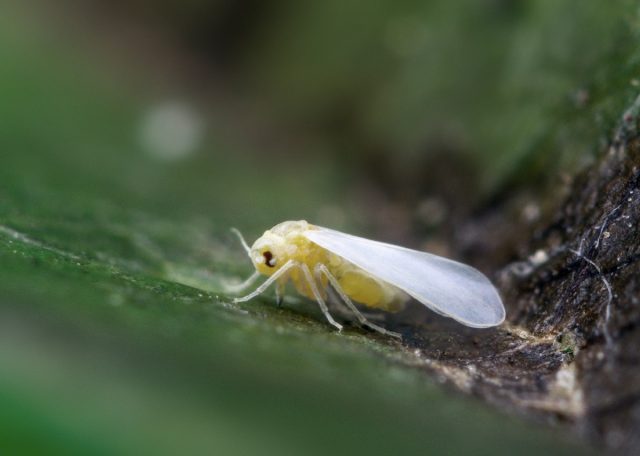How to prevent and treat whiteflies
List of contents
When talking about whiteflies, many people might think of some kind of common fly, but in reality these are not flies at all. Rather, they belong to a group of insects called Homoptera, which includes such well-known species as cicadas, aphids and mealybugs. Whiteflies belong to the family of Aleyrodidae, which includes more than 1,500 species of whiteflies.
These flying insects look like tiny white moths that are about 1-2 mm long in females (males are smaller), with three pairs of legs and two to four wings, depending on the species. The body is covered with a thin layer of waxy secretions, in the form of a mealy-looking powder produced by ventral glands. The most common in marijuana is Trialeurodes vaporariorum, whose body is slightly yellowish and has four wings, in the resting state are parallel to the body.
The whitefly moves quickly and is easily noticed flying around the infected plant. Their life cycle is between 10 and 30 days, and during this time they can reproduce several times, the females laying between 80 and 300 eggs each time, so their proliferation is very rapid. These eggs adhere to the underside of the leaf and do not detach easily.
After about six days these eggs hatch and give rise to transparent, practically invisible crawling nymphs, which then lose their legs as they begin their pupal stage, which has 3 phases, until they finally become adults. Their rapid life cycle of just 3 weeks means that things can get bad very quickly when conditions are favourable for them.
Conditions for whitefly emergence
This pest is much more prevalent during warmer times of the year (or when plants lack the necessary nutrients) so it can be found predominantly in tropical climates. It is particularly problematic in greenhouses, where whiteflies are protected from predators, giving them the perfect opportunity to establish colonies. They can also withstand cold conditions, allowing them to reproduce throughout the year.
In the case of cannabis they tend to have a greater incidence in indoor crops, where they find the ideal conditions for their development, at temperatures between 20ºC and 27 ºC, precisely the thermal range where the marijuana plant feels most comfortable. High relative humidity, as well as a lack of aeration, also favour its presence. Excess nitrogen in your plants will also attract whiteflies and other enemies of your crop, such as thrips and spider mites.
How to detect a whitefly infestation
Whiteflies live on the underside of leaves, where they lay their eggs and feed on the sap by piercing the outer soft tissues. This damage eventually becomes noticeable on the tops of leaves. Although small, these flying insects can develop in large numbers and drain nutrients from your plants quickly.

In addition, whiteflies can transmit numerous viruses through their bites, producing various diseases that can be spread to plants. Whiteflies acquire viruses from infected weeds or cultivated plants and then transmit them within minutes to healthy plants.
Like aphids, whiteflies leave a sweet, sticky excrement known as honeydew, which can cause the formation of sooty mould, an opportunistic fungus that manifests as a kind of black powder on the surface of leaves, further weakening plants by preventing them from photosynthesizing properly.
Beyond the visible traces of sooty mould, there are other symptoms of whitefly infestation that can be detected before it is too late. For example:
- Flies that fly off when the plant is shaken: the most obvious and unmistakable sign is to see the insects flying off the underside of the leaves.
- Chlorosis: the marijuana leaves begin to lose its green color, dries out and eventually dies.
- Slow growth: as the infestation spreads on the marijuana plant, its metabolic functions slow down, production decreases, and the deterioration of the crop becomes evident, acquiring an increasingly weak and sickly appearance.
- Perforated leaves: very characteristic circular marks produced by suction, of a yellowish color and with a tiny inner spot produced by the pest’s dental apparatus, having a dual function (biting and sucking).
- Tiny eggs: barely 0.25 millimeters (use of a magnifying glass is advisable), left on the underside of the leaves.
- The appearance of a white powder: it surrounds the egg clusters and is secreted by the adults through their abdominal glands for protection, just as the mealybug can do.
- The presence of ants: they are irremediably attracted by the sweet honeydew; this is a symbiotic relationship that favors both species, since the ants obtain food, the honeydew, and the whitefly receives protection.

Treatment to eradicate the whitefly
Treating whiteflies is a challenge, as they are insects that can quickly develop a tolerance to insecticides and other chemical pesticides. Depending on the severity of the infestation, multiple treatments are likely to be needed. Some work best for killing eggs and nymphs, while others are more suitable for adults. Here are some methods you can use:
Physical methods
- Level of effectiveness: low
- Remove affected leaves: Because of the way whiteflies aggregate, parts or entire leaves may be removed. Pruning is the most direct way of eliminating whitefly nymphs, but it is unlikely to eradicate them completely.
- Clean plants: It may sound like a joke, but blasting them with a hose (if you grow outdoors) can scatter whiteflies and help loosen eggs and nymphs 'fused' to the underside of leaves. Use common sense: be careful not to use too much pressure, and do so only on more developed plants.
- Insect-trapping adhesive strips: Another method is to place yellow adhesive strips with pheromones near your plants, as this type of fly is attracted to yellow. The whiteflies will stick to them when you shake the plants and get them to fly off it.
One of the main objectives of whitefly control is to prevent the crop from being infected by any of the viruses that these insects may carry, so it is important to eliminate weeds or the detritus of other plants near the crop.
Biological methods
- Effectiveness level: high
Among the possible natural solutions, you can also resort to biological pest control; that is, introduce on your crop “allies” that kill not only the adult flies, but also their larvae and eggs.
- Lacewings (Chrysopa), ladybugs (Delphastus) and predatory mites (Phytoseiidae) have been known to feast on whiteflies. The Encarsia formosa wasp is also capable of keeping the pest at bay if we introduce two or more individuals, and a predatory bug such as Macrolophus caliginosus is another voracious predator of this species.
- Verticillium lecanii is a beneficial fungus, an entomogenous parasite widely used worldwide for the biological control of whiteflies and aphids (to a lesser extent, thrips and spider mites). It acts by ingestion and contact, and can be used with full confidence as it leaves no residues and is completely harmless to humans and animals.
- If you grow marijuana outdoors, practice polyculture or the "crop association", which is nothing more than planting other plants nearby that repel whiteflies: marigolds, Chinese carnations and basil work wonders.

Organic methods
- Level of effectiveness: very high
- Neem oil can really help keep whiteflies from spreading quickly. The adults won't want to land on plants that have been sprayed, and the nymphs die after ingesting it. It is so effective that it can even deter ants. Apply 2-3 times per week, washing the leaves of the plants on both sides, being very careful not to break them.
- Horsetail: one of the most effective fungicides in organic farming, which is even recognized as an insecticide against aphids and red spider mites. Use one part horsetail to 4 parts water. Spray late in the afternoon all over the plant, particularly on the underside of the leaves. For prevention it can be used every 6 days and, if it is to treat an area, repeat every two or three days.
- Insecticidal soaps work well for all types of cannabis pests and can be used effectively against whiteflies. They are completely safe, but it is best not to spray them on buds. For example: in 1.5 liters of water, add a tablespoon of neutral soap and spray your plants in the late afternoon, once a week.
- Ecological remedies: if your crop is already affected, apart from the abovementioned steps, you can use different ecological insecticides, such as rotenone and pyrethrins (commonly used in organic farming as an alternative to chemical products). They work well, and their usage can be alternated with other insecticides, such as tansy or wormwood infusions.
Chemical methods
- Level of effectiveness: theoretically, extreme
If all else fails, you can always resort to a chemical insecticide of the many brands that exist in the market. You must be aware, however, that the whitefly is capable of immunizing itself against some of these products, and that those most affected by this type of treatment are the larvae. If you are looking for organic and environmentally-friendly growing, as well as total safety for consumers, we do not recommend the use of chemical products.

Tips to prevent the appearance of whiteflies
It goes without saying that prevention is always the best solution to any potential pest problem. In this case cleanliness is close to godliness; having a cultivation spot that is as tidy and clean as possible is key, as well as proper growing conditions that do not put your cannabis plants at risk.
Recommendations in this regard range from installing powerful fans for indoor cultivation, with which to prevent flies from landing on our plants, to placing filters in all ventilation slots to prevent any insect from getting into the room. If you are working with cuttings from other growers, it is very important that new plants being introduced in the growing space undergo quarantine for at least a week to ensure that they are not infected.
And of course, limit humidity, apply efficient ventilation and preventing the ambient temperature from being too high (above 25ºC), since this favors onset of the dreaded white fly, an insect that you will want to do everything you can to prevent.





